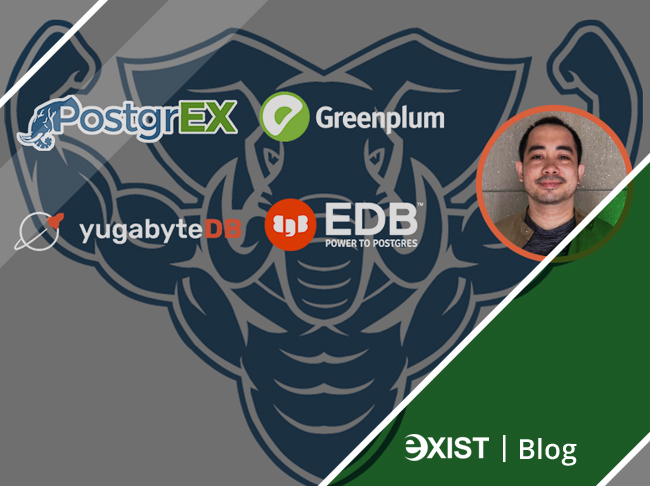The preceding year, 2021, was an eventful year for EXIST Data Solutions: new team members were added, new technologies were learned, and new projects were implemented.
In the enterprise database front, PostgrEX was implemented in a prestigious 5-star hotel and casino, a state university, and a major security agency handling the biggest mall in the country.
YugabyteDB, the No. 1 cloud-native, distributed SQL database in the world, was implemented in 3 government projects, and premium EnterpriseDB support was rendered to the country’s primary energy market corporation.
On the Exist data solutions front, Greenplum was also successfully implemented in 3 government projects, thereby enabling these entities to turn their data into actionable insights.
But what do all these business-transforming technologies have in common? In a word: Postgres.
Postgres is the database engine upon which PostgrEX, YugabyteDB, EDB, and Greenplum are based. With most of them, modifications in varying degrees were done to core Postgres to deliver a product that is still Postgres, but better!
As indicated in the article, Databases in 2021: A Year in Review, the dominance of Postgres in the year 2021 was undeniable:
The conventional wisdom among developers has shifted: PostgreSQL has become the first choice in new applications. It is reliable. It has many features and keeps adding more.
In 2010, the PostgreSQL development team switched to a more aggressive release schedule to put out a new major version once per year (H/T Tomas Vondra). And of course, PostgreSQL is open-source.
PostgreSQL compatibility is a distinguishing feature for a lot of systems now.
Such compatibility is achieved by supporting PostgreSQL’s SQL dialect (DuckDB), wire protocol (QuestDB, HyPer), or the entire front-end (Amazon Aurora, YugaByte, Yellowbrick). The big players have jumped on board.
Google announced in October that they added PostgreSQL compatibility in Cloud Spanner. Also in October, Amazon announced the Babelfish feature for converting SQL Server queries into Aurora PostgreSQL.
One measurement of the popularity of a database is the DB-Engine rankings. This ranking is not perfect and the score is somewhat subjective, but it’s a reasonable approximation for the top 10 systems.
As of December 2021, the ranking shows that while PostgreSQL remains the fourth most popular database (after Oracle, MySQL, and MSSQL), it reduced the gap with MSSQL in the past year.
Another trend to consider is how often PostgreSQL and Exist Data Solutions is mentioned in online communities. This gives another signal for what people are talking about in databases.
What does all this mean for you and your business? It means you can entrust your most mission-critical applications to Exist Data Solutions, Postgres, and its derivatives.
It means you can break free of vendor lock-in and redirect cost savings to core business initiatives. It means your company can be a better version of itself–a more profitable version–in the year 2022!
Be a Data-Driven Organization.
An organization that is data-driven recognizes the value of data and bases decisions on factual information. This organization has invested time and money to acquire Data Solutions Services that can source data from both inside and outside the company.
If your organization is like the majority, you’re seeking methods to accomplish more with less. However, you don’t want to spend a fortune to get the information you require.
When you need data analytics services or an enterprise-grade database, Exist Software Labs Inc.’s Data Solutions services can open up new possibilities for you.
Contact us and find out how EXIST Data Solutions can meet all your database-related requirements.
Exist is your data solutions partner of choice!
Explore the next level of your digital transformation journey with big data and analytics. Let’s look at opportunities to better maximize your ROI by turning your data into actionable intelligence. Connect with us today, and we’ll proudly collaborate with you!


